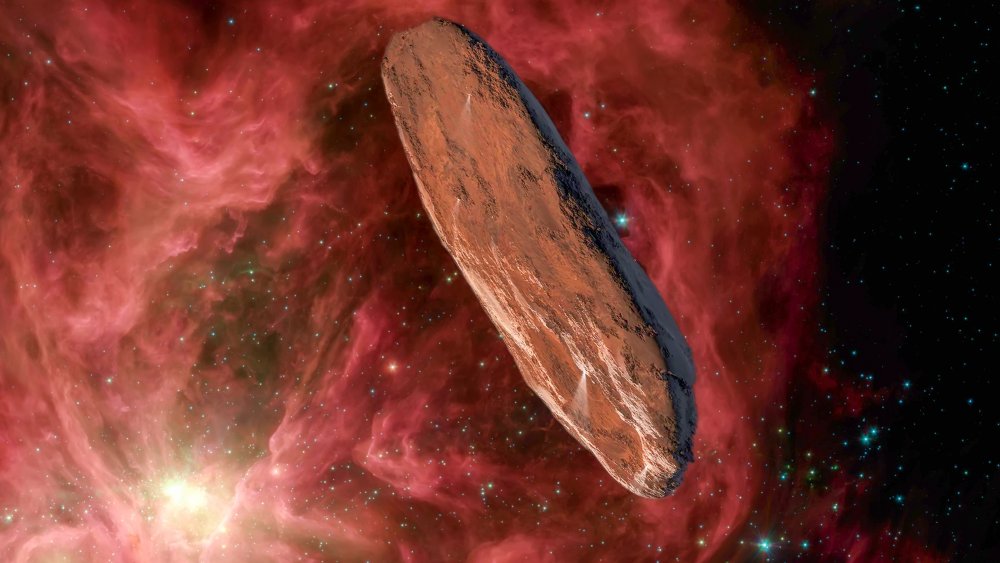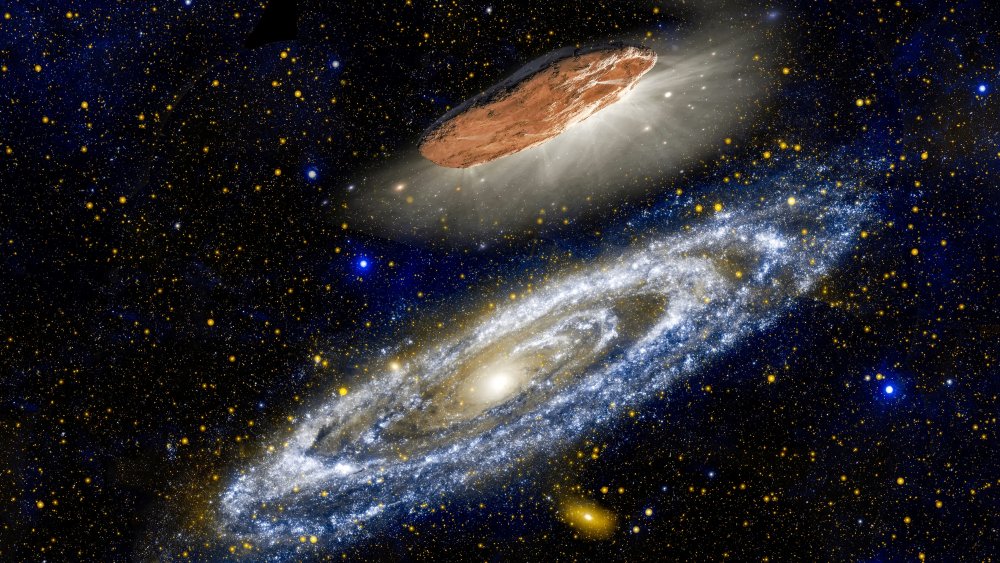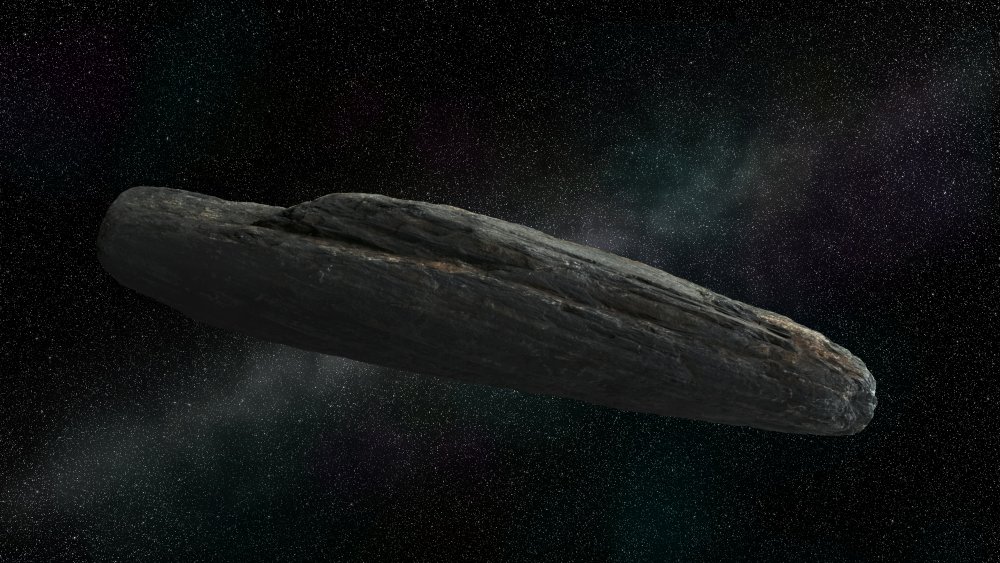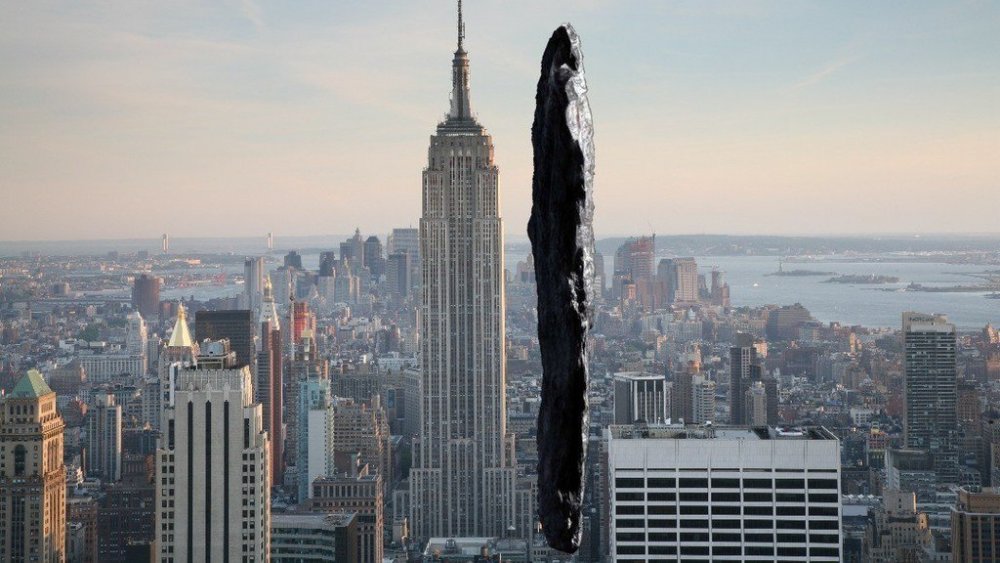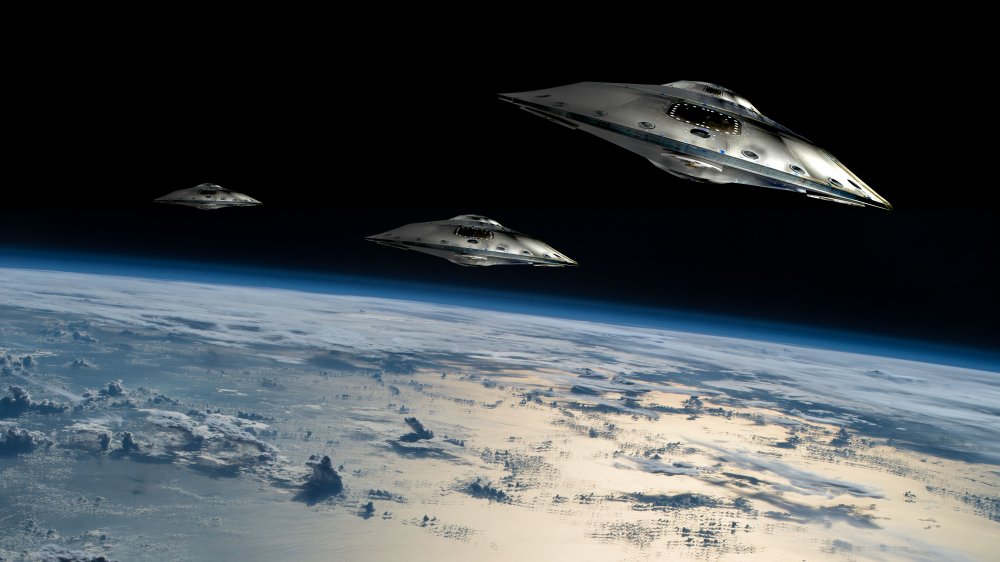The Untold Truth Of The Interstellar Object Known As 'Oumuamua
Space. The final frontier. A place so endless, so bizarre, and so utterly incomprehensible to the human mind that every time those know-it-all Earthlings think they've got it figured out, they have to rewrite the book. Just ask poor Pluto, the cosmic rock that got so infamously demoted to being a "dwarf planet" in the 2000s.
Every once in a while, though, something so colossally weird appears in space that even the most reasonable expectations sound wonky. That's what happened in 2017, when a cigar-shaped object named 'Oumuamua drifted in from another solar system, popped up on your news feed, and said hello. Years later, certain people still think it was a flying saucer, others are planning missions to land on its surface, and the "object" itself is just drifting further away. Here's the truth about why this big ol' intergalactic anomaly got the science community so stirred up ... and, you know, whether or not aliens are the cause.
Yes, 'Oumuamua is the space cigar you remember reading about
You probably saw this wacky thing on your Facebook back in October of 2017, and no, it wasn't some joke article by the Onion. Back then, 'Oumuamua's unusual shape led to it being commonly referred to as a "space cigar," which probably got a lot of cigar fans excited until they realized they couldn't light it up, much less puff on it. C'mon, guys.
Anyhow, the reason that the sighting of this space cigar mattered, as explained by Space.com, is because it marked the very first time that an "interstellar object" from outside the solar system had ever been witnessed by Earthling eyes: in layperson's terms, that means that it was a rock originating the furthest reaches of unknown space. Now, in a sci-fi movie, foreboding music would play as brain-eating arachnids crept out from its surface, but in real life, the scientific community just got jazzed about how weird this thing was. The experts found it freaky enough that 'Oumuamua had no "coma" — AKA the cloud of dust and gas that buzzes around comets as they near the sun — but when you add in the surfboard shape, reddish hue, and the potential for frozen water inside it, you end up with a landmark discovery that, to this day, people are still scratching their heads over.
'Oumuamua was found by accident
The brave discoverer of this uncharted weirdo object was the University of Hawaii's Robert Weryck, a postdoctoral researcher. Crazily enough, according to NBC News, the cigar's unearthing was a lucky accident, just like that time you found a $20 bill in your couch cushion. Back on October 19th, 2017, when Weryck decided to check out the views in Maui's Pan-STARRS telescope, the only thing he was looking for were asteroids that might be approaching Earth — you know, like that one that knocked off the dinosaurs — when, instead, he found the galaxy's biggest cigar. Oops?
Upon examining the foreign object in two images snapped the night before, it made even less sense: see, because 'Oumuamua is so flat and long, it actually tumbles through space like a bad swimmer. This flip-over happens about every eight hours or so, meaning that every time you complete a workday, you can rest assured that 'Oumuamua has done a fresh somersault. Amusing as this may be, what most interested Weryck and company was the fact that the object originated from outside the solar system, making it the interstellar "visitor" that scientists had been hunting for over the course of decades.
How'd 'Oumuamua get such an awesome name?
Well, it certainly didn't petition for it. 'Oumuamua was named as such by the Hawaiian Pan-STARRS team who first spotted it, according to Scientific American. Fittingly enough, it's a Hawaiian word, the meaning of which roughly translates to "leader," or "scout," or "a messenger from afar arriving first." Pretty cool. Now, if you care about accuracy (and you should!) don't be guilty of the mistake that so many other publications and Twitters users make, by not properly punctuating the name: the okina, as the European Southern Observatory points out, is what you call the little Hawaiian punctuation mark, resembling an apostrophe, that goes before the first O.
So, 'Oumuamua is correct, while Oumuamua is wrong. Got it?
Now, of course, every scientific phenomenon gets to have its own fancy scientific designation. Since 'Oumuamua was a brand new type of space object, it received an "I" — as opposed to the "A" that asteroids get, or the "C" reserved for comets — resulting in the final name being 1I/2017 U1. Which is great, but definitely not as catchy as 'Oumuamua.
The game to figure out what this weird 'Oumuamua thing is
When 'Oumuamua first tumbled onto humankind's telescope screens, it got the entire scientific community firing on all cylinders. Why? Because nobody could quite figure out what it was. Some speculated it might be a zombie comet, according to Space.com, which might sound like something from a Doom game, but is actually a creepy nickname for when a comet gets obliterated by the sun, leaving just dusty remnants in its wake. Interesting visual, but definitely not 'Oumuamua. Other researchers pondered whether it might be a planetesimal, which is what you call a hunk of rock that gets separated from a real planet: think of how Superman's homeworld of Krypton got blown into tiny smithereens of kryptonite, and you'll get the basic idea. Other scientists suggested that it should be considered a new class of space object altogether.
These days, now that some years have passed, most science folks tend to consider 'Oumuamua as a comet. A really bizarre one ... but still a comet, nonetheless. This classification is based on the object's rather fast speed, which points toward it being propelled by outgassing (the release of trapped gas), which is exactly what pushes comets through space. That said, what if 'Oumuamua isn't a rock? What if it's something a bit more, well, extraterrestrial?
Cue that X-Files theme ...
So, 'Oumuamua ... it must be aliens, right?
Admit it. That's what you (and that crazy-haired dude on the History Channel, probably) have been thinking the whole time, right? Don't worry, you're not the only ones.
Pretty much as soon as 'Oumuamua arrived, the people of Earth bit their collective fingers, wondering if this might finally be an alien spaceship everyone is waiting for. Initially, the scientific community brushed off such speculation. That changed when Avi Loeb, the head of Harvard University's astronomy department, jumped into the fray, according to NBC News. Loeb didn't necessarily believe that 'Oumuamua was an artificial alien structure, per se, but he used his prestige to point out that scientists should at least be open to the possibility. Loeb wrote a paper examining this notion, and his frankness opened the door for other scientists to openly speculate on the whole "Hey ... aliens?" thing without getting laughed out of the room. As Loeb put it, "The point of doing science is not to have a prejudice." Boom.
Once Loeb lit the fuse, it was time to test for aliens. How does one go about that, you ask? Well, you listen for radio signals, according to the Guardian, which is why researchers at the Breakthrough Listen project probed 'Oumuamua using a telescope with ears so strong that it could've picked up a mobile phone in space. Unfortunately, the response was negative. No signals, no aliens, nada ... at least, so far as Earth technology can pinpoint.
When it comes to 'Oumuamua, never rule out alien 'light sails'
The first rule about alien phenomenon? Usually, it's not aliens. The second rule? Be open-minded, just in case. Just ask Ray Norris, of Western Sydney University in Australia. While Norris concedes that the evidence for alien life on 'Oumuamua is minimal, at best, he does think it's important to not entirely rule out the notion that it could conceivably be an abandoned alien vessel from countless years ago. As he puts it, "... we cannot discount the possibility that it really is a spacecraft — perhaps one that got into trouble a long time ago and its corpse continues to tumble for eternity through the vastness of interstellar space."
Eerie thought, isn't it?
One theory proposed by Professor Avi Loeb and Shmuel Bialy, in defense of the extraterrestrial hypothesis, is that 'Oumuamua could be a so-called "light sail" spacecraft. A light sail, as explained by Phys.org, would be a form of spaceship that generates propulsion through radiation pressure. In regard to why such a vessel would just tumble into Earth's solar system and not exhibit any radio signals, they again mention the possibility that 'Oumuamua could be a relic, while also suggesting that, alternatively, it could be an active piece of technology sent to explore our part of space, kind of like how humans sent out the Mars Rover. Now, to be clear, neither of these guys are UFOlogists. They're not saying that this thing is artificial, just that it could be. Take that as you will.
Microbes on 'Oumuamua, though ... that's a different story
If aliens are hitching a ride on 'Oumuamua — which, again, is nothing but blatant speculation — they probably aren't humanoid creatures with big heads, robots, xenomorphs, or anything so exciting. Think smaller. Way smaller. As in, alien bacteria.
"Galactic Panspermia," according to the Harvard Crimson, is the theory that the chemical compounds for life can be spread across the universe by space objects like asteroids, meteoroids or, you know, cosmic cigars. 'Oumuamua, as it turns out, might be ideally suited to carry millions of these little suckers inside it. Why? Because, as Wired explains, the interstellar object seems to possess a hardened, dry crust, rich in carbon, which is perfect for protecting a cold, water-dense (read: icy) core from getting vaporized by solar rays. Moisture, as your moldy basement proves, is great for growing bacteria. And bacteria, as Space.com points out, can survive for millions of years provided it has the right conditions. There could be countless 'Oumuamua-type interstellar objects flying around, dumping their proverbial guts onto new worlds, and creating life. Depending on one's outlook, that's either a wondrous example of the universe's magic, or an isolating Lovecraftian horror. Up to you.
However, there's no proof that 'Oumuamua is made of ice. In fact, when it approached the sun, it didn't really behave like an icy object tends to, which casts some doubt on this whole idea. That said, if you ever find yourself digging into 'Oumuamua's crust, bring some hand sanitizer.
Where did 'Oumuamua come from?
'Oumuamua and Luke Skywalker have more in common than you might think. No, really. Both 'Oumuamua and Luke have trekked across the universe with peaceful intentions. Both of them changed the status quo in their own respective ways. Their most striking similarity, according to a study published by the Monthly Notices of the Royal Astronomical Society, is that 'Oumuamua also originates from a "binary" solar system — AKA, one that orbits around two suns, instead of one — just like on Luke's home sweet home, Tatooine.
Since leaving those twin suns behind, this lonely space cigar has undertaken many grand quests, most of which predate the existence of humankind. Yeah, it's that old. Over three million years ago it seems to have skated near a yellow dwarf star named HD 292249, according to Cornell University, and just one million years ago it waved hello to a red dwarf named HIP 3757. By the time Earth's telescopes located this ancient adventurer, according to NBC News, it had the constellation Lyra in its tailwinds, and its GPS set for Pegasus, up ahead. Its brief cruise through your solar system, by the way, was less of a rest stop and more like those highway signs you briefly acknowledge on a long road trip: as reported by NASA, the object's brief dalliance with Jupiter, Saturn, and the rest will end very soon, as it twirls back into space, away from the sun, and out of Earth's reach forever.
How big is 'Oumuamua, really?
Now, maybe you're looking to draw some sick illustration of 'Oumuamua crashing into Earth, perhaps for the album cover of your friend's metal band. Cool beans. However, if you're trying to get an accurate sense of this rock's size and scale, understand that it's awfully big, according to Mashable. So big that if you stacked it up next to the Empire State Building, you'd have to get a ruler to decide which one wins the height contest. Seriously, does the antenna count?
Before you get too freaked out about the fact that such a massive object drifted so close to your little home planet, understand that Empire State Building-sized rocks pass by Earth all the time. Another one named 2006 QQ23 just squeaked past Earth in August of 2019, according to CNN, and this happens around six or so times a year. Even scarier, at least one asteroid that got yanked into the sun's orbit was 21 miles across, which is almost the driving distance from Hollywood to Redondo Beach. Admittedly, while there are plenty of bigger rocks in space, they aren't as freaky-looking as 'Oumuamua, so your album cover concept should probably stick with the big cigar.
Are there more of these interstellar objects out there?
Oh yeah, for sure. Not necessarily space cigars, perhaps, but NASA estimates that interstellar objects like 'Oumuamua pass by Earth several times a year. In the past, telescopes weren't advanced enough to detect these hidden, space-faring rocks, but today, technology is moving fast, so there'll be lots of new sightings in the future. Keep in mind, according to Space.com, that scientists believe there are trillions upon trillions of interstellar objects floating through this very galaxy, at this very second, which humankind just hasn't spotted yet. Um, invasion of the alien cigars, much?
2019 saw the discovery of the second interstellar comet, according to Science News, which was promptly named 2I/Borisov. Theoretically, this thing would just be 'Oumuamua's cigar-shaped little brother, but instead, 2I/Borisov possesses the shape, size, halo, and other features of an everyday comet. Yawn. So, in essence, this second interstellar object's mundane features makes the first object's uniqueness sparkle even brighter. Don't worry, 'Oumuamua, you'll always be Earth's favorite.
Project Lyra, AKA the only way to rule out aliens on 'Oumuamua for sure
Okay, so 'Oumuamua is weird. It's funky. Scientists don't quite get why it doesn't fit into the right boxes, people on Earth always blame aliens (because it's more fun), and meanwhile, the object itself is twirling further away by the day. At times like this, you have to ask ... what would Captain Kirk do?
Well, he'd fly there and check out the damn thing himself, of course. And so, meet Project Lyra, the hypothetical plan regarding how human beings could send a ship into the stars, dock on 'Oumuamua, and finally get solid answers. Alien conspiracies aside, 'Oumuamua's ancient origins and distant mileage could bring about an explosion of new scientific understandings, research, and observations, so the effort is worthwhile ... and, according to the research behind Project Lyra, entirely feasible. Existing and/or near-term technology is capable of getting something out there, and the experts behind Project Lyra suggest a good launch date would be sometime after 2024. The one catch, pointed out by Science Alert, is that Lyra's calculations are based on 'Oumuamua traveling at is original speed of 95,000 kilometers per hour. It's not moving at that speed anymore, and it will be a few years before it goes back to it.
Nonetheless, landing something on 'Oumuamua — or, at least, the next interstellar object that comes along — could bring about some of the greatest discoveries in history. Besides, it'd be a great boon to science fiction novelists across the world.
